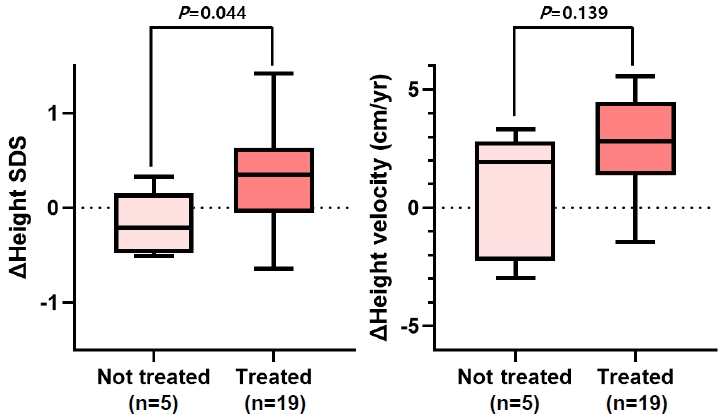 |
 |
- Search
| Ann Pediatr Endocrinol Metab > Volume 28(2); 2023 > Article |
|
Abstract
Purpose
Methods
Results
Conclusions
Supplementary material
Supplementary Fig. 1.
Notes
Funding
This study received no specific grant from any funding agency in the public, commercial, or not-for-profit sectors.
Fig. 1.

Table 1.
Values are presented as number (%) and median (interquartile range).
ALL, acute lymphoblastic leukemia; AML, acute myeloid leukemia; CML, chronic myeloid leukemia; GHD, growth hormone deficiency; SDS, standard deviation score; BMI, body mass index; CNS, central nervous system; TBI, total body irradiation; GVHD, graft-versus-host disease; HSCT, hematopoietic stem cell transplant.
Table 2.
Values are presented as number (%) and median (interquartile range).
GHD, growth hormone deficiency; SDS, standard deviation score; BMI, body mass index; hGH, human growth hormone; TSH, thyroid-stimulating hormone; HOMA-IR, homeostatic model assessment of insulin resistance; HDL, high-density lipoprotein; LDL, low-density lipoprotein; IGF-1, insulin-like growth factor 1; IGFBP-3, insulin-like growth factor-binding protein 3; r-hGH, recombinant hGH.
Table 3.
| Variable | At GHD diagnosis | After 1 year of GH treatment | P-value |
|---|---|---|---|
| Free T4 (ng/dL) | 1.33 (1.09–1.38) | 1.23 (1.14–1.38) | 0.488 |
| TSH (mIU/L) | 2.56 (2.10–3.78) | 3.16 (1.50–4.80) | 0.817 |
| Cortisol (µg/mL) | 6.38 (1.87–9.38) | 6.59 (4.04–9.62) | 0.583 |
| Glucose (mg/dL) | 90.00 (80.75–112.25) | 94.00 (88.00–104.00) | 0.620 |
| Hemoglobin A1c (%) | 5.10 (4.85–5.58) | 5.40 (5.10–5.70) | 0.205 |
| Insulin (µU/mL) | 11.22 (8.99–20.15) | 15.43 (8.90–29.28) | 0.574 |
| HOMA-IR | 2.84 (1.97–5.27) | 3.43 (1.94–7.50) | 0.650 |
| Total cholesterol (mg/dL) | 181.00 (143.00–201.00) | 162.00 (142.00–190.00) | 0.258 |
| Triglyceride (mg/dL) | 117.50 (75.00–140.50) | 103.00 (86.00–136.00) | 0.893 |
| IGF-1 SDS | -1.40 (-1.9 to -0.74) | -0.07 (-0.78 to 1.10) | <0.001* |
| IGFBP-3 SDS | -1.54 (-2.22 to -0.78) | -0.73 (-1.31 to 0.61) | 0.022* |
Values are presented as number (%) and median (interquartile range).
GH, growth hormone; GHD, growth hormone deficiency; TSH, thyroid-stimulating hormone; HOMA-IR, homeostatic model assessment of insulin resistance; IGF-1, insulin-like growth factor 1; IGFBP-3, insulin-like growth factor-binding protein 3; SDS, standard deviation score.
Table 4.
| Variable | B coefficient | 95% CI | P-value |
|---|---|---|---|
| At leukemia diagnosis | |||
| Age | 0.619 | -0.129 to 1.368 | 0.091 |
| Height SDS | 0.311 | -2.175 to 2.797 | 0.776 |
| BMI SDS | 0.233 | 0.064 to 0.401 | 0.019* |
| Leukemia type | -0.101 | -2.615 to 2.412 | 0.927 |
| Steroid treat duration | -0.027 | -0.073 to 0.019 | 0.211 |
| Accumulated steroid dose | -0.001 | -0.001 to 0.001 | 0.624 |
| At GHD diagnosis | |||
| Age | 0.071 | -0.493 to 0.635 | 0.775 |
| BA | 0.221 | -0.257 to 0.699 | 0.311 |
| Difference between chronic age and BA | -1.007 | -1.930 to -0.084 | 0.037* |
| Height SDS | 1.193 | 1.000 to 1.385 | <0.001* |
| Δ Height SDS† | 1.127 | 0.738 to 1.516 | <0.001* |
| BMI SDS | 0.751 | 0.240 to 1.263 | 0.010* |
| Average peak hGH‡ | 0.348 | -0.338 to 1.034 | 0.269 |
| Free T4 | 5.239 | -5.505 to 15.983 | 0.287 |
| TSH | 1.179 | 0.576 to 1.781 | 0.002* |
| Cortisol | -0.172 | -0.323 to -0.021 | 0.031* |
| Glucose | -0.063 | -0.118 to -0.008 | 0.031* |
| Hemoglobin A1c | -1.619 | -3.748 to 0.509 | 0.115 |
| HOMA-IR | -0.206 | -0.354 to -0.057 | 0.014* |
| Total cholesterol | 0.018 | -0.034 to 0.071 | 0.429 |
| Triglyceride | 0.004 | -0.044 to 0.051 | 0.862 |
| IGF-1 SDS | 0.307 | 0.033 to 0.695 | 0.121 |
| IGFBP-3 SDS | 0.056 | 0.203 to 0.366 | 0.692 |
| r-hGH dose | 0.033 | -0.124 to 0.190 | 0.631 |
SDS, standard deviation score; GH, growth hormone; GHD, growth hormone deficiency; BMI, body mass index; BA, bone age; hGH, human growth hormone; TSH, thyroid-stimulating hormone; HOMA-IR, homeostatic model assessment of insulin resistance; IGF-1, insulin-like growth factor 1; IGFBP-3, insulin-like growth factor-binding protein 3; r-hGH, recombinant human growth hormone.







